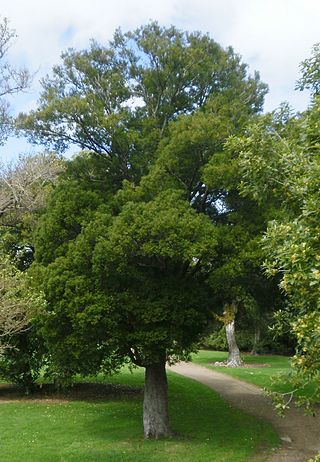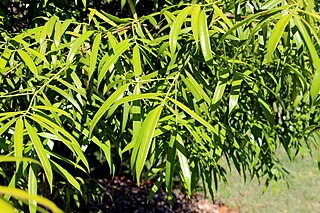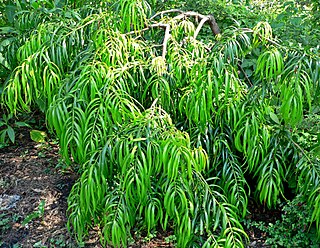
Podocarpus totara is a species of podocarp tree endemic to New Zealand. It grows throughout the North Island and northeastern South Island in lowland, montane and lower subalpine forest at elevations of up to 600 m.

Prumnopitys taxifolia, the mataī or black pine, is an endemic New Zealand coniferous tree that grows on the North Island and South Island. It also occurs on Stewart Island/Rakiura but is uncommon there.

Podocarpus is a genus of conifers, the most numerous and widely distributed of the podocarp family, the Podocarpaceae. The name comes from Greek πούς + καρπός. Podocarpus species are evergreen shrubs or trees, usually from 1 to 25 m tall, known to reach 40 m (130 ft) at times. The cones have two to five fused cone scales, which form a fleshy, berry-like, brightly coloured receptacle at maturity. The fleshy cones attract birds, which then eat the cones and disperse the seeds in their droppings. About 97 to 107 species are placed in the genus depending on the circumscription of the species.

Prumnopitys is a genus of conifers belonging to the family Podocarpaceae. The nine recognized species of Prumnopitys are densely branched, dioecious evergreen trees up to 40 metres in height.

Podocarpus macrophyllus is a conifer in the genus Podocarpus, family Podocarpaceae. It is the northernmost species of the genus, native to southern Japan and southern and eastern China. Common names in English include yew plum pine, Buddhist pine, fern pine and Japanese yew. Kusamaki (クサマキ) and inumaki (犬槇) are Japanese names for this tree. In China, it is known as luóhàn sōng (羅漢松), which literally means "arhat pine".

Sundacarpus is a monotypic genus of conifers containing a single species Sundacarpus amarus, belonging to the family Podocarpaceae. Sundacarpus was designated a genus by C.N.Page in 1989; formerly it had been classified variously as a species of Podocarpus or of Prumnopitys.

Dacrycarpus dacrydioides, commonly known as kahikatea and white pine, is a coniferous tree endemic to New Zealand. A podocarp, it is New Zealand's tallest tree, gaining heights of 60 m and a life span of 600 years. It was first described botanically by the French botanist Achille Richard in 1832 as Podocarpusdacrydioides, and was given its current binomial name Dacrycarpus dacrydioides in 1969 by the American botanist David de Laubenfels. Analysis of DNA has confirmed its evolutionary relationship with other species in the genera Dacrycarpus and Dacrydium.

Podocarpus lawrencei is a species of podocarp native throughout the Australian high country, from southern Tasmania through to the New South Wales highlands. Common names are Errinundra plum-pine and mountain plum-pine. It grows on exposed sites to 1,800 m, often forming living carpets over rocks through wind pruning.

Podocarpus spinulosus, the dwarf plum pine or spiny-leaf podocarp, is a species of podocarp native to the warm-temperate coastal regions of New South Wales and southern Queensland. It is generally an understorey shrub, rarely growing more than 2 m tall.

Podocarpus drouynianus is a species of podocarp native to the relatively high rainfall southwestern corner of Western Australia, where it is known by the name emu berry, wild plum or native plum although it is not a true plum. The Noongar name for the plant is koolah.

Podocarpus nubigenus is a species of podocarp, endemic to the Valdivian temperate rain forests of southern Chile and adjacent southwestern Argentina. It is the southernmost podocarp in the world. It grows from 38°S to Ultima Esperanza (53°S), in wet and swampy soils. It can settle clear grounds, with a faster growth than the other Chilean Podocarpaceae.

Podocarpus elatus, known as the plum pine, the brown pine or the Illawarra plum, is a species of Podocarpus endemic to the east coast of Australia, in eastern New South Wales and eastern Queensland.
Podocarpus capuronii is a species of conifer in the family Podocarpaceae. It is endemic to Madagascar.
Podocarpus epiphyticus is a species of conifer in the Yew Pine family (Podocarpaceae). It is found only in Myanmar (Burma). It was discovered by David J. DeLaubenfels and John Silba in the Kachin state in the early 1980's. It is most notable for being the only epiphyte in the Podocarp family.
Podocarpus fasciculus is a species of conifer in the family Podocarpaceae. It is found in Japan and Taiwan. It is threatened by habitat loss.
Podocarpus hispaniolensis is a species of conifer in the family Podocarpaceae. It is endemic to the Dominican Republic.

Podocarpus matudae is a species of conifer in the family Podocarpaceae. It is found in Guatemala, El Salvador, Honduras and Mexico.

Podocarpus salignus, the willow-leaf podocarp, is a species of coniferous evergreen tree in the family Podocarpaceae. It is found only in Chile, from 35 to 42° south latitude, where it is threatened by habitat loss. Growing up to 20 m (66 ft) in height and 1 m (3 ft) in diameter, the trunk is straight and cylindrical, with reddish-gray bark. The arching branches bear long, narrow, willow-like leaves, and red fleshy oval fruits where male and female plants are grown together. In Chile it is known as Mañío de hojas largas (long-leaved).

Podocarpus sprucei is a species of conifer in the family Podocarpaceae. It is found largely in Ecuador and Peru.
Netta Elizabeth Gray (1913–1970) was an American botanist. She was a specialist in the conifer genus Podocarpus and much of her research material, including anatomical microscope slides, are now housed at the U.S. National Arboretum in Washington, D.C.
















